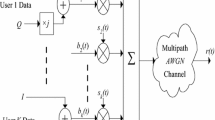Abstract
An adaptive antenna array is incorporated into a decorrelatingmulti-user detector to effectively increase the DS-CDMA system capacity.Capacity improvement is due to beamforming gain, spatial diversity gain(assuming large angle spread), and the decorrelating effect. Thereceiver has been analyzed for the cases of sufficiently andinsufficiently spaced receiving antennas. The receiver consists of afront-end beamformer for every user in the cell and has knowledge of allusers' signature sequences. The beamformer estimates the desired userchannel vector, enhancing its signal and reducing the co-channelinterference from other directions. The multi-user detection, exploitingknowledge of other users, rejects those interferers whose arrival anglesare close to that of the desired user. The average uncoded Bit ErrorRate (BER) as a function of the number of in-beam active users, theaverage antenna Signal-to-Noise Ratio (SNR), and the number of receivingantennas is examined in both single-path and multi-path Rayleigh fadingchannels. Analysis shows an increase in system capacity proportional tothe number of receiving antennas.
Similar content being viewed by others
References
A.J. Viterbi, Principles of Spread Spectrum Multiple Access Communications, Addison-Wesley: MA, 1995.
D. Schilling, L.B. Milstein, R.L. Pickholtz, F. Bruno and E. Kanterakis et al., “Broadband CDMA for Personal Communications Systems”, IEEE Commun. Magazine, Vol. 29, No. 11, pp. 86–93, 1991.
A. Baier, U.C. Fiebig, W. Granzow, P. Teder and J. Thielecke, “Design Study for a CDMA-Based Third-Generation Mobile Radio System”, IEEE J. Select. Areas Commun., Vol. 12, No. 4, pp. 733–743, 1994.
H. Vincent Poor and G.W. Wornell, Wireless Communications: Signal Processing Prospectives, Prentice Hall, 1998.
Sergio Verdu, Multiuser Detection, Cambridge University Press: U.K., 1998.
J. Litva, T. Kwok and Yeung Lo, Digital Beamforming in Wireless Communications, Artech House Publishers: Boston, London, 1996.
R.A. Monzingo and T.W. Miller, Introduction to Adaptive Arrays, John Wiley and Sons: NY, 1980.
A. Naguib, “Adaptive Antennas for CDMA Wireless Networks”, Ph.D. thesis, Stanford University, 1995.
Nermin A. Mohamed and J.G. Dunham, “Performance Analysis of CDMA Mobile Systems Using Antenna Arrays and Multi-User Detection”, in Proceedings of the 32nd Asilomar Conference on Signals, Systems and Computers, Pacific Grove, CA, Nov. 1–4, 1998, pp. 1833–1837.
Nermin A. Mohamed and J.G. Dunham, “Performance Analysis of an Antenna Array-Based CDMA Receiver Using Multi-User Detection in a Multipath Channel”, in Proceedings of the IEEE VTC'99, Houston, TX, May 16–19, 1999, pp. 1623–1627.
J. Proakis, Digital Communications 3rd edn., McGraw-Hill Inc., 1995.
G.L. Turin, “The Effects of Multipath and Fading on the Performance of Direct Sequence CDMA systems”, IEEE Trans. Veh. Tech., Vol. VT-33, pp. 213–219, 1984.
A. Paulraj and C. Papadias, “Space-Time Processing for Wireless Communications”, IEEE Signal Processing Magazine, Vol. 14, No. 6, pp. 49–83, 1997.
B. Suard, A. Naguib, G. Xu and A. Paulray, “Performance Analysis of CDMA Mobile Communication Systems Using Antenna Arrays”, in Proceedings of ICASSP'93, Vol. VI, MN, pp. 153–156, 1993.
S. Anderson, M. Millnert, M. Viberg and B. Wahlberg, “An Adaptive Array for Mobile Communication Systems”, IEEE Trans. Veh. Tech., Vol. 40, pp. 230–236, 1991.
A.F. Naguib and A. Paulray, “Performance of Wireless CDMA with M-ary Orthogonal Modulation and Cell Site Antenna Arrays”, IEEE J. Select. Areas Commun., Vol. 14, No. 9, pp. 1770–1783, 1995.
Z. Zvonar and D. Brady, “Suboptimal Multi-User Detector for Frequency Selective Rayleigh Fading Synchronous CDMA Channels”, IEEE Trans. Commun., Vol. 43, No. 2/3/4, pp. 154–157, 1995.
S. Kapoor, S. Gollamudi, S. Nagara; and Y. Huang, “Adaptive Multiuser Detection and Beamforming for Interference Suppression in CDMA Mobile Radio Systems”, IEEE Trans. Veh. Tech., Vol. 48, No. 5, pp. 1341–1355, 1999.
Nermin A. Mohamed and J.G. Dunham, “A Simple Combined Conjugate Gradient Beamforming and Interference Cancellation Scheme for DS-CDMA in a Multipath Fading Channel”, in Proceedings of the IEEE Wireless Communications and Networking Conference, WCNC'99, New Orleans, Sept. 21–24, 1999, pp. 859–863.
Author information
Authors and Affiliations
Rights and permissions
About this article
Cite this article
Mohamed, N.A., Dunham, J.G. A Combined Antenna Array and Multi-User Detection DS-CDMA Receiver in Single-Path and Multi-Path Fading Channels. Wireless Personal Communications 20, 251–265 (2002). https://doi.org/10.1023/A:1014451425318
Issue Date:
DOI: https://doi.org/10.1023/A:1014451425318




